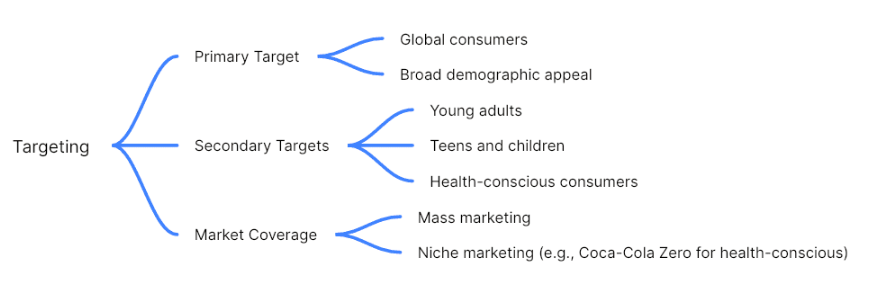The marketing realm can often seem a maze of jargon and acronyms, a labyrinth that might leave those uninitiated feeling somewhat lost. However, delve into this fascinating world, and you'll soon see the exciting mechanics of it all, and there's no better example of marketing prowess than the beloved global brand, Coca-Cola. In this detailed study, we'll explore the Coca-Cola segmentation, targeting and positioning strategies, commonly referred to as STP. These critical processes form the crux of their successful marketing campaign and have significantly contributed to Coca-Cola's worldwide recognition and lasting legacy.
Mind Map: Coca-Cola Segmentation, Targeting, and Positioning
To begin our journey, let's picture a mind map in the whitebord. This representation will guide us through the intricate landscape of Coca-Cola's segmentation, targeting, and positioning strategy. This mind map acts as our compass in this exploration. Through it, we will navigate these three crucial areas, diving into Coca-Cola's market segmentation before proceeding to their targeting strategy and finally surfacing with a deep understanding of their positioning tactics.
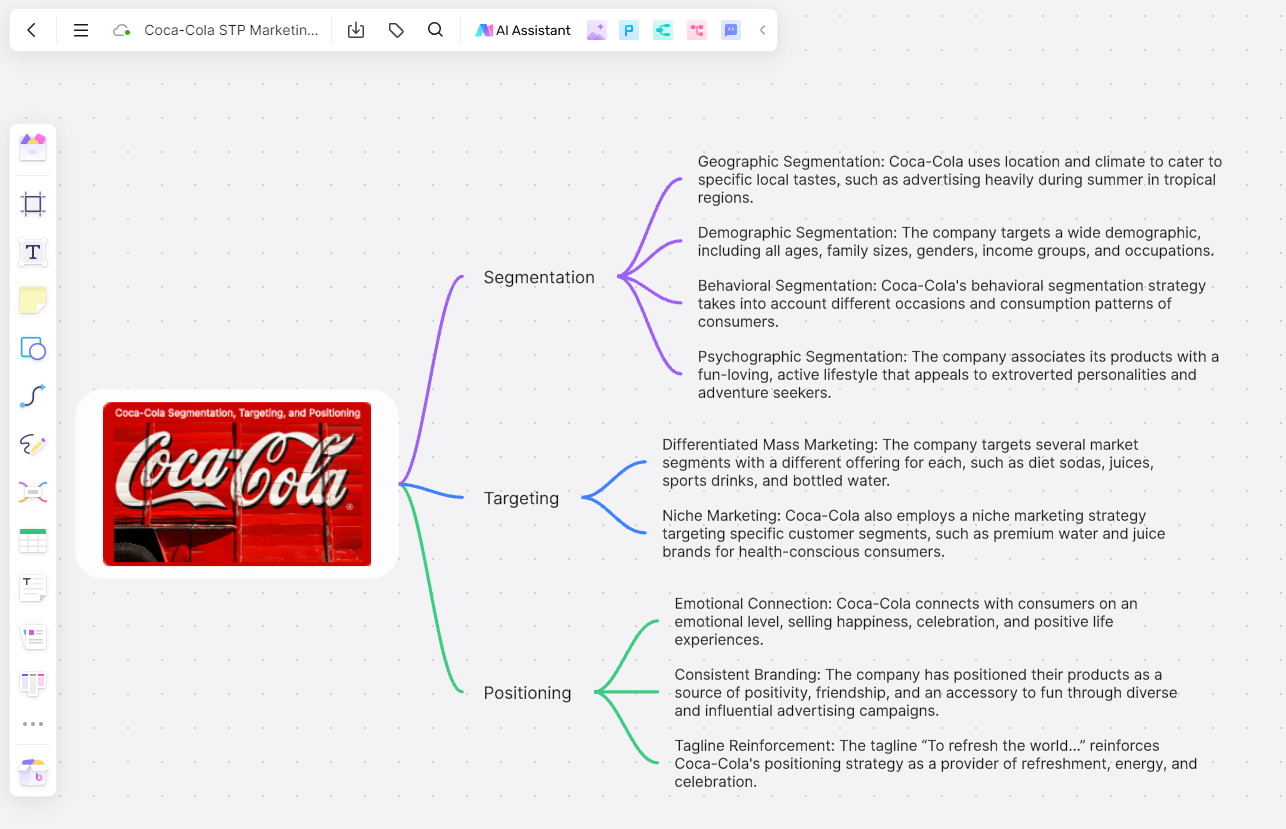
Market Segmentation of Coca-Cola
In the vast and intricate world of marketing, market segmentation forms the backbone of any successful marketing strategy. It is the process of subdividing a large, heterogeneous market into identifiable segments with similar needs, wants, or demand characteristics. The essence is to better tailor marketing efforts to meet the needs of these segments. It is in this area that Coca-Cola truly excels. Their approach to market segmentation is a prime example of understanding consumer profiles and enhancing their buying experience.
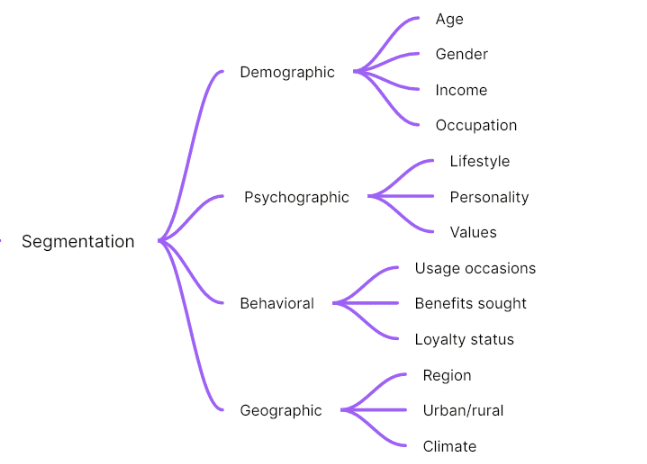
Understanding the needs of different demographics is a vital starting point. Coca-Cola's market stretches across the globe, making its consumer base incredibly diverse. These consumers, irrespective of their geographic location, have different beverage preferences and consumption habits. To cater to such a diverse clientele, Coca-Cola's segmentation strategy revolves around four critical pillars: geographic, demographic, behavioral, and psychographic segmentation.
Geographic Segmentation:
Coca-Cola uses geographic segmentation as one of their main marketing strategies, taking into account the location and climate of various regions to cater to specific local tastes. For instance, in tropical regions like India, the consumption of cold beverages rises significantly during summers; Coca-Cola focuses heavily on advertising during this time in these regions. Conversely, in colder climates such as in Northern Europe or Canada, Coca-Cola pushes for higher sales during holiday seasons like Christmas when soda consumption tends to increase.
Demographic Segmentation:
Demographic segmentation forms another cornerstone of Coca-Cola's marketing strategy. They do not limit themselves to a specific age group or gender. Instead, they target a wide demographic spanning all ages, family sizes, genders, income groups, and occupations. They produce drinks that cater to children's whimsical tastes like cherry-flavored cola or vanilla-flavored cola for mature tastes.
Behavioral Segmentation:
Coca-Cola's behavioral segmentation strategy takes into account the different occasions and consumption patterns of consumers. They recognize that consumption varies from person to person and occasion to occasion. A prime example would be Coca-Cola's 'Share a Coke' campaign, which beautifully capitalized on personal consumption experiences by replacing the standard Coca-Cola logo on bottles with people's names.
Psychographic Segmentation:
Last but not least, Coca-Cola ventures into psychographic segmentation. They are acutely aware that people's lifestyles, attitudes, and personality traits influence their buying behavior. They associate their products with a fun-loving, active lifestyle that appeals to extroverted personalities and adventure seekers.
Targeting of Coca-Cola
Once the market segmentation has been set, the following step in marketing strategy is to determine the target market. It is this stage where Coca-Cola again reveals its proficiency in understanding its consumer base and maximizing the potential of its expansive product line. It's crucial to identify which segments to pursue, how to approach them, and what marketing strategies will yield the most positive results. Coca-Cola does so with a twofold strategy – differentiated mass marketing and niche marketing.
Differentiated Mass Marketing:
Through differentiated mass marketing, Coca-Cola targets several market segments with a different offering for each. Their beverage portfolio isn't limited to just the signature cola. Coca-Cola's line extends to a variety of other beverages like diet sodas, juices, sports drinks, and bottled water. These products target different age groups and cater to diverse lifestyles and health preferences. For instance, diet sodas cater to health-conscious consumers or those with specific dietary needs, while energy drinks appeal to younger demographics leading an active lifestyle.
Niche Marketing:
Parallel to the differentiated mass marketing, Coca-Cola also employs a niche marketing strategy targeting specific customer segments. Examples of this would be their range of premium water and juice brands targeted at the health-conscious segment of consumers willing to pay higher prices for organic or natural ingredients.
Moreover, Coca-Cola also cleverly aligns its products with various occasions such as family dinners, parties, festive celebrations, and sporting events, thereby creating multiple consumption contexts. These contextual links between their products and these occasions in consumer's minds form another layer of Coca-Cola's targeting strategy.
Their constant innovation in new flavors, healthy product choices, and sleek packaging designs helps them appeal to these different target segments. Their marketing campaigns aim to create brand recognition and preference among these specific target groups to influence purchasing decisions. Hence, through a smart combination of mass marketing and niche marketing, Coca-Cola targets a vast array of consumer segments, ensuring its global reach and extensive consumer base.
Positioning of Coca-Cola
Market positioning refers to the ability to influence consumer perception regarding a brand or product. It is about defining how you want your product to be perceived by customers in the market and what sets your product apart from competitors. Coca-Cola excels in its positioning strategy and has created an image that is quite powerful and unparalleled in the beverage market.
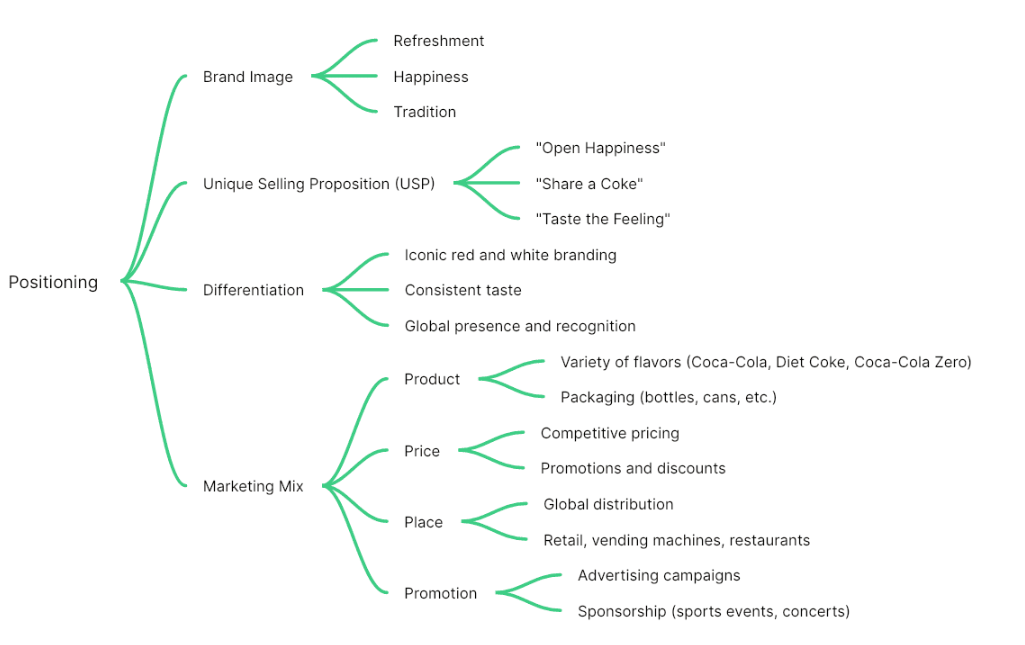
A great deal of Coca-Cola's positioning success comes from its ability to connect with consumers on an emotional level. They don't just sell a beverage; they sell happiness, celebration, and positive life experiences packaged in a bottle. Through their diverse and influential advertising campaigns, they have positioned their products as a source of positivity, friendship, and an accessory to fun. Their ads often depict happy, smiling people sharing moments of joy with a bottle of Coca-Cola. This consistent branding has imbued Coca-Cola with an emotional aspect that its competitors find challenging to replicate.
The concept is simple, yet powerful – When people think of Coca-Cola, they don't just think of a soda; they associate it with a lifestyle of joy, happiness, and sharing special moments with loved ones. This association is their brand position – a cheerful and refreshing addition to any social interaction. Coca-Cola has not just positioned itself in the beverage industry but has also embedded itself in our culture and daily life.
The tagline of Coca-Cola also reinforces this positioning strategy. “To refresh the world...” might seem like an ambitious statement, but it precisely reflects the image that Coca-Cola represents in the minds of its consumers. It serves to reinforce the idea that Coca-Cola is not just a thirst-quencher but also an instant provider of refreshment, energy, and celebration.
This positioning is not solely limited to their flagship cola drink but also extends to their other beverage varieties. Whether it is Diet Coke for those who prefer a healthier alternative or a Fanta for those seeking fun and vibrant flavors, each product reinforces the brand's overall positioning strategy.
Hence, through powerful advertising and consistent messaging, Coca-Cola has established a strong market position that goes beyond being just another beverage company. They've become an integral part of people's lives, signifying positivity, fun, and refreshment, making them stand out in a crowded market.
Coca-Cola Segmentation, Targeting, and Positioning Cheat Sheet
Think of this as your takeaway cheat sheet summarizing Coca-Cola's masterful marketing approach with their segmentation, targeting, and positioning strategy. This at-a-glance guide serves to remind us of the genius behind Coca-Cola's sustained success.
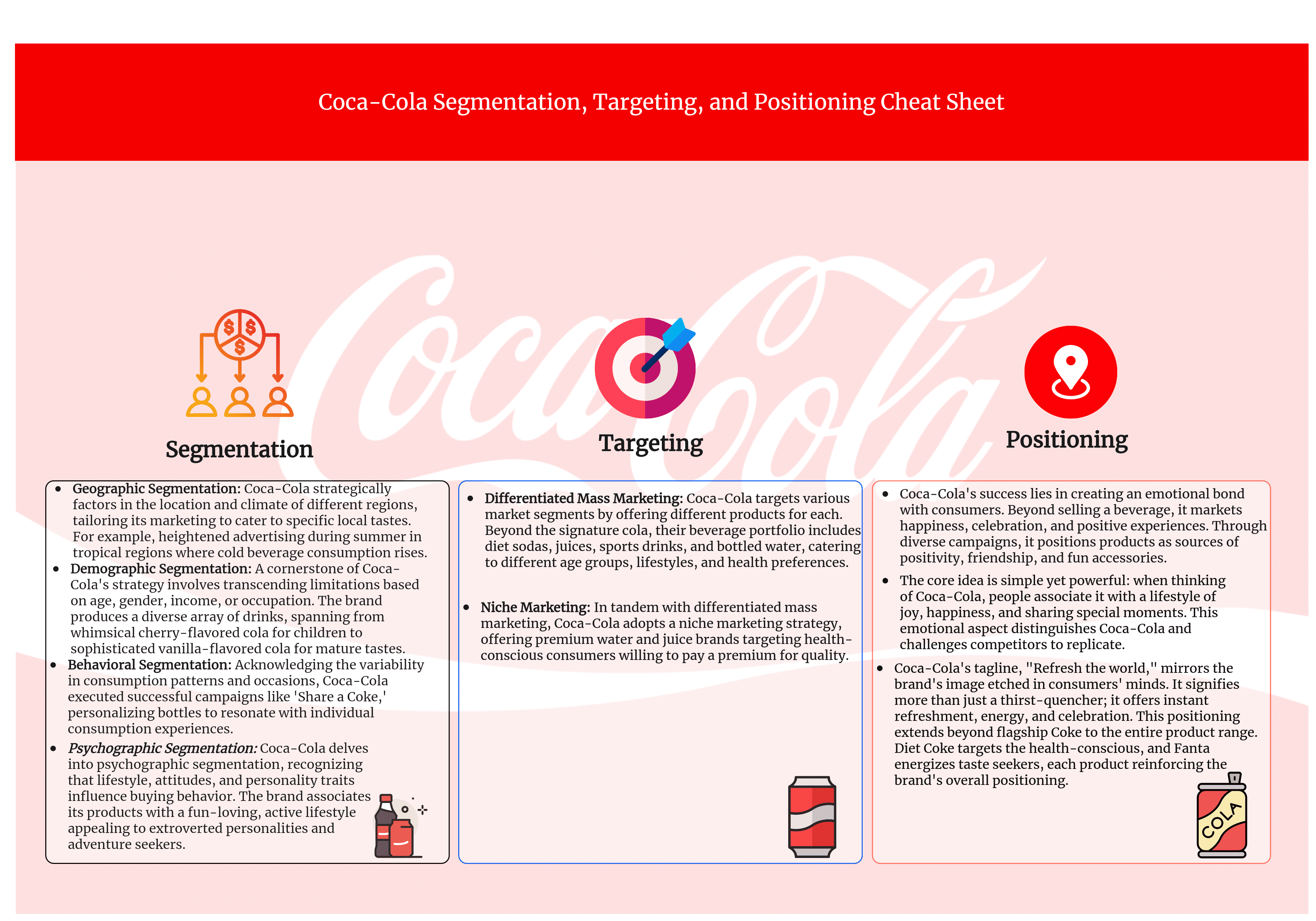
Key Takeaways: STP Template & Tool
Our exploration into Coca-Cola's segmentation, targeting, and positioning strategies provides valuable insights into the mechanisms behind successful marketing campaigns. These core strategies can be replicated in your business endeavors via our solution Boardmix. To make it even easier, we have pre-built diagram templates to assist you in your journey to marketing success.
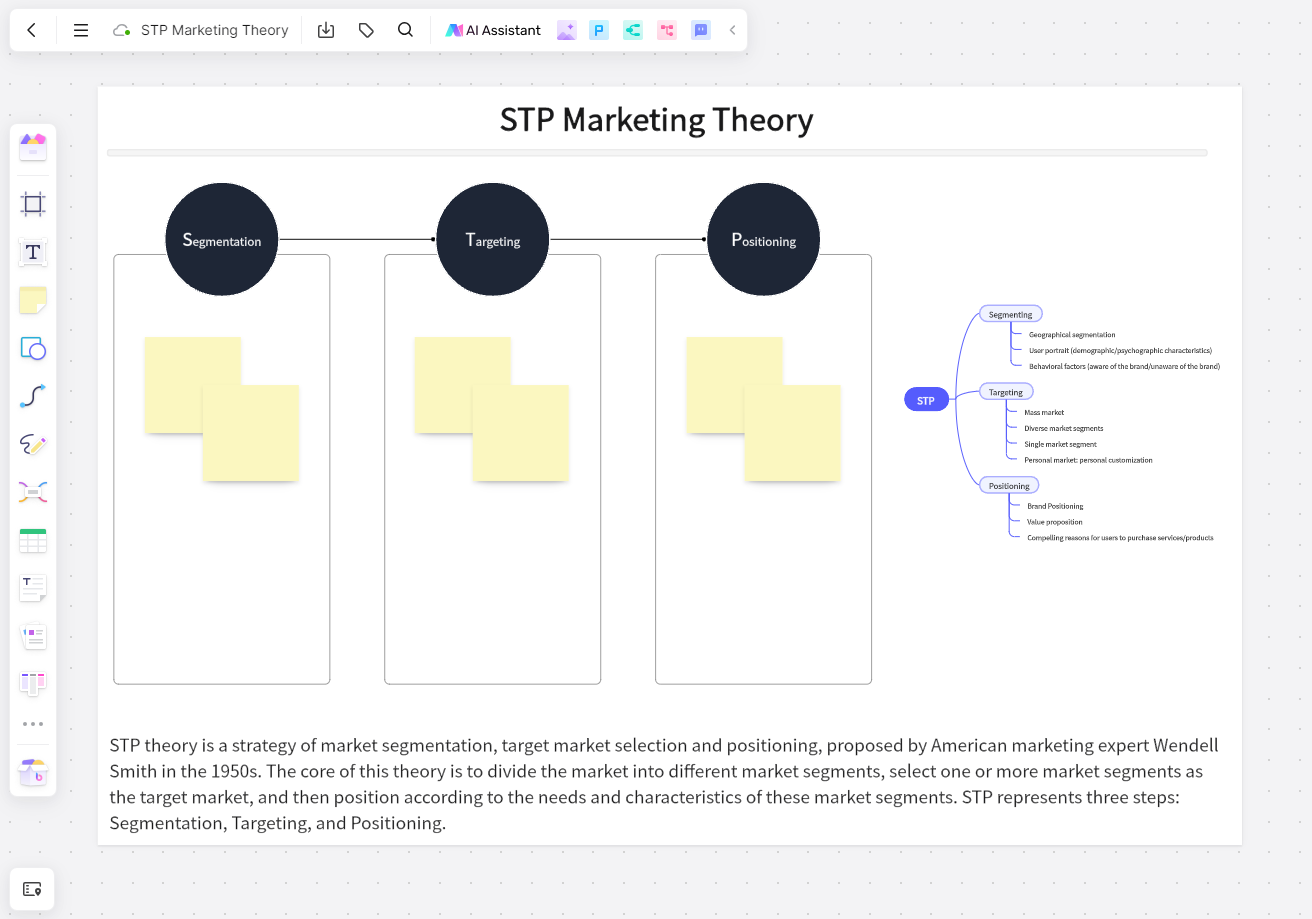
Boardmix is an instrumental tool designed to tap into your creativity and bring structure to your ideas. With its digital canvas, it empowers users for online collaboration involving sceneries like design research, marketing analysis, business plans, daily meetings, weekly plans, and online education. It offers a one-stop solution of an online whiteboard, flowcharts, mind maps, brainstorming, hybrid work, scrum tool, and so on. Boardmix also integrated comprehensive AI-generation features like AI Presentation, AI Image, AI Mind Map, and so on. BoardMix's online whiteboard combines advanced technology with ease of use, simplifying team brainstorming, data analysis, document drafting, and information visualization.
In essence, Boardmix stands as a multifaceted tool that brings a new dimension to idea generation and thought organization. With its straightforward interface, collaborative features, adaptive templates, smooth integrations, and budget-friendly pricing, Boardmix Mind Mapping certainly merits a try. Experience how it can transform your mind-mapping process. Try to make your analysis with Boardmix right now!






